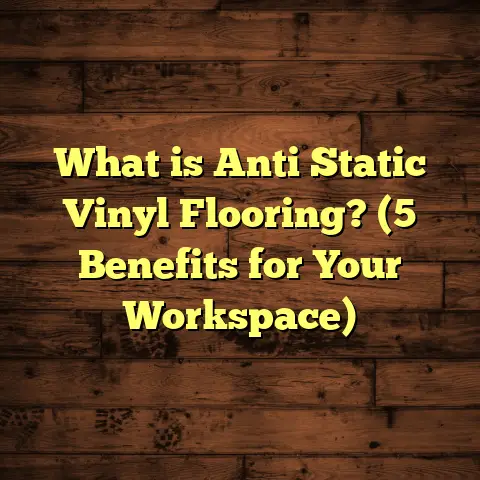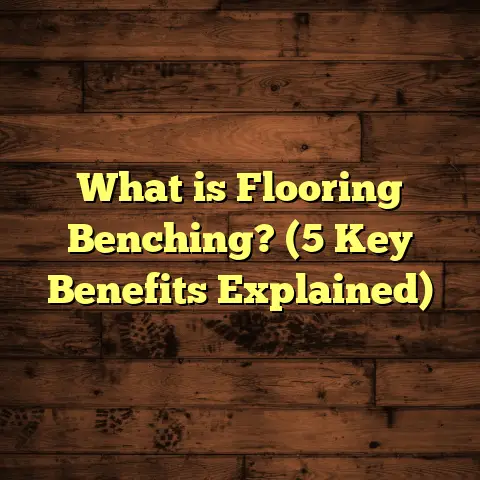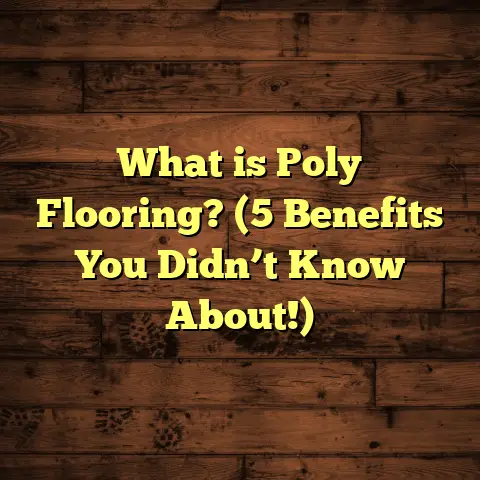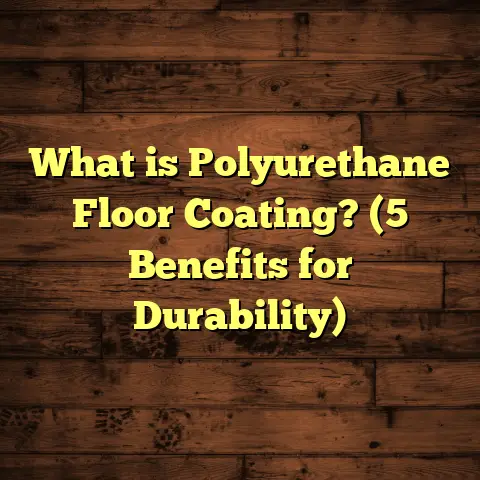What is Resilient Vinyl Flooring? (5 Benefits You Need to Know)
I love the feeling of walking barefoot on a floor that’s smooth yet soft enough to ease the tension in my feet after a long day. There’s something about the subtle bounce underfoot, the quiet resilience that a good floor offers, making a room feel inviting and comfortable. This is exactly why I want to chat with you about resilient vinyl flooring—a flooring choice I’ve grown pretty fond of over the years. If you’ve ever wondered what makes it stand out or whether it could be right for your space, stick around. I’ll share what I’ve learned firsthand, along with some technical details and practical insights.
What Is Resilient Vinyl Flooring?
Let’s start with the basics: what exactly is resilient vinyl flooring? Simply put, it’s a type of synthetic flooring designed to replicate the look and feel of natural materials like wood, stone, or ceramic, but with added durability and flexibility. The “resilient” part refers to its ability to bounce back after pressure or impact, which means it doesn’t dent or crack easily under weight or movement.
Vinyl flooring itself is made from polyvinyl chloride (PVC), a plastic polymer known for its toughness and water resistance. Resilient vinyl comes in several forms—sheet vinyl, vinyl tiles, and luxury vinyl planks (LVP)—each offering different installation methods and design options.
How It’s Made: A Quick Look at the Manufacturing Process
Understanding how resilient vinyl flooring is made gives you an idea of why it performs so well. The production involves layering several components:
- Backing layer: This is usually made from fiberglass or felt. It provides stability and support.
- Core layer: Typically PVC-based, this layer adds thickness and durability.
- Printed design layer: Through advanced printing technology, manufacturers can create realistic textures and images that mimic wood grain, stone patterns, or other surfaces.
- Wear layer: This transparent topcoat protects the design from scratches, stains, and wear. The thicker the wear layer, the more durable the flooring.
- UV coating: Some products include this to prevent fading from sunlight exposure.
The entire assembly is pressed and cured under heat and pressure to ensure strong adhesion between layers. The result is a product flexible enough to absorb shocks but tough enough for heavy use.
Deeper Dive Into Each Layer’s Role
It’s easy to overlook just how much each layer contributes. For example, the backing layer often includes fiberglass embedded in PVC, which prevents stretching or shrinking as temperature changes. This keeps the floor dimensionally stable over years.
The core layer can be rigid or flexible depending on the product type. Rigid cores provide better dent resistance but can be less forgiving on uneven subfloors. Flexible cores conform better but might sacrifice some durability.
The printed design layer has evolved dramatically thanks to digital printing technology. This means manufacturers can produce floors with incredibly lifelike visuals—even including tiny knots in wood grain or subtle veining in stone—that you can’t easily spot from real materials without close inspection.
Why I Recommend Resilient Vinyl Flooring: 5 Benefits You Need to Know
I’ve installed various flooring types over the years—from hardwood to tile—but resilient vinyl stands out for several reasons. Here are five benefits that keep me coming back to it for different projects.
1. Durability That Lasts
One time, I worked on a family’s kitchen remodel where hardwood floors just weren’t practical due to moisture concerns. We went with resilient vinyl planks instead. After two years, despite spills, dropped pots, and heavy foot traffic, the floor still looked almost new.
Vinyl flooring’s wear layers range from 6 mil (thousandths of an inch) to over 20 mil for commercial-grade products. Higher wear layers mean better resistance to scratches and dents. According to industry data from the Resilient Floor Covering Institute (RFCI), properly maintained resilient vinyl can last anywhere from 10 to 20 years—a solid lifespan considering its cost and ease of replacement.
Another point worth mentioning: the wear layers often contain urethane or aluminum oxide for added scratch resistance. This means pets’ nails or moving furniture cause less damage.
Layers Matter — What About Thickness?
Thickness also plays into durability. Most residential resilient vinyl ranges from 2 mm to 5 mm thick. Commercial products can go beyond 8 mm. Thicker floors absorb shocks better and feel more solid underfoot.
From my experience installing floors in homes with kids and pets, I find 4 mm thick luxury vinyl planks with a 20 mil wear layer hit a sweet spot between comfort and long-lasting performance.
Real-World Durability Testing
I once participated in a demo where manufacturers showed how different wear layers reacted under simulated foot traffic and dropping tools. Floors with less than 12 mil wear layers showed visible scratches after 1,000 cycles; those with 20+ mil wear layers barely showed signs of wear even after 5,000 cycles.
This hands-on experience sold me on choosing products with thicker wear layers for spaces expecting heavy use.
2. Water Resistance That Protects Your Investment
Living in a humid climate myself, I’ve seen how moisture can ruin floors fast. Resilient vinyl’s PVC core and waterproof surface make it ideal for kitchens, bathrooms, basements, and laundry rooms. Unlike hardwood or laminate, it won’t warp or swell when exposed to water.
In one project, a client accidentally flooded their laundry room overnight. Thanks to the vinyl flooring, cleanup was straightforward with no lasting damage—something that wouldn’t have been possible with other flooring types.
Beyond just being waterproof on the surface, many modern vinyl floors have specially designed locking mechanisms that prevent water seepage between planks or tiles—especially important for floating installations.
Mold & Mildew Resistance
Because it resists moisture penetration, resilient vinyl also minimizes mold growth risk under the floorboards—a crucial health consideration for families with allergies or respiratory issues.
Comparison With Other Floors Regarding Water Damage
- Hardwood: Prone to swelling and cupping when wet.
- Laminate: Core swells significantly upon water exposure.
- Tile: Waterproof but grout lines can allow moisture penetration.
- Carpet: Absorbs moisture and harbors mold if not dried quickly.
In contrast, resilient vinyl’s waterproof nature saves you money on repairs and replacement over time.
3. Comfortable Underfoot & Quiet
Ever walked on tile or stone for hours? Your feet can really complain afterward. Resilient vinyl has a bit of cushioning due to its layered construction—especially when paired with an underlayment. This provides comfort and reduces noise from footsteps.
I remember installing luxury vinyl planks in a daycare center where noise control was essential. The floor helped minimize echoes and made the space more pleasant for both kids and staff.
How Comfort Translates To Real Life
If you spend a lot of time standing—say in your kitchen or workshop—resilient vinyl’s slight give helps reduce fatigue compared to harder floors like ceramic tile.
Adding padded underlayment beneath floating vinyl adds an extra layer of shock absorption without compromising stability.
Noise Reduction Benefits
Hard surfaces tend to reflect sound waves which amplifies noise levels indoors. Vinyl flooring absorbs some sound energy due to its flexible layers. This is why apartments or condos often prefer vinyl—it helps keep footsteps quieter for neighbors below.
How Thickness Affects Comfort & Noise
Generally speaking:
| Thickness | Comfort Level | Noise Absorption |
|---|---|---|
| <2 mm | Low | Minimal |
| 3-5 mm | Moderate | Good |
| >5 mm | High | Excellent |
For quieter environments like offices or bedrooms, thicker resilient vinyl with quality underlayment is a smart choice.
4. Design Versatility That Fits Any Style
If you’re someone who loves changing up your decor every few years like me, resilient vinyl gives you tons of options without breaking the bank. Its printed design layer can mimic almost any material—wood grains from rustic oak to exotic teak, slate stones, even metallic finishes.
The latest models even feature embossed textures that make you want to reach down and touch the surface because it feels so authentic.
Why Design Matters More Than You Think
I had a client obsessed with Scandinavian style but reluctant about hardwood because of cost and maintenance worries. Luxury vinyl planks offered her clean light wood visuals without fuss while fitting her budget perfectly.
If you want patterns like herringbone or chevron but don’t want complicated installation or expense associated with real wood or tile mosaics, resilient vinyl tiles can replicate those looks easily.
Latest Trends In Vinyl Flooring Design
- Textured finishes that mimic hand-scraped or wire-brushed wood.
- Wider plank options (7-9 inches) for more modern aesthetics.
- Mixed material looks combining wood visuals with stone tile patterns.
- Bold colors and geometric prints for accent areas or commercial spaces.
Manufacturers are pushing boundaries constantly—so you’re not limited like with traditional materials.
Customization Possibilities
Some companies offer custom-print options where you can upload your own pattern or logo for commercial projects—a neat way to personalize space branding without heavy investment.
Case Study: A Restaurant Makeover
A trendy restaurant I worked on wanted rustic barnwood floors but needed durability against spills and heavy cleaning schedules. We installed luxury vinyl planks with distressed wood visuals plus a textured finish for slip resistance.
Customers loved the look; staff appreciated how easy it was to maintain; owners saved thousands compared to hardwood installation.
5. Easy Maintenance Saves Time and Money
I’m not a big fan of spending hours cleaning floors every week. Resilient vinyl makes maintenance simple: regular sweeping or vacuuming plus occasional damp mopping keeps it looking great.
Unlike carpet that traps dirt or hardwood that needs refinishing, vinyl doesn’t require special cleaners or treatments. Plus, spills wipe right up without staining if addressed promptly.
What Maintenance Looks Like Day-to-Day
My routine usually involves:
- Sweeping daily or every other day.
- Damp mopping weekly using mild detergent.
- Spot cleaning spills immediately.
No waxing required, no polishing needed—just straightforward upkeep.
Avoiding Common Mistakes
Avoid harsh chemicals like bleach or ammonia-based cleaners which can degrade wear layers over time.
Also steer clear of abrasive scrubbers that might scratch the surface.
Longevity Boosters
Using furniture pads under chairs and tables prevents scratching during moves.
Area rugs at entryways reduce tracked-in dirt which wears down floors faster.
Technical Specifications: What Makes Resilient Vinyl Tick?
To give you a better idea about what you’re dealing with when choosing resilient vinyl flooring, here’s a breakdown of typical specs:
| Feature | Typical Range/Value |
|---|---|
| Thickness | 2 mm – 8 mm (sheet & planks) |
| Wear Layer Thickness | 6 mil – 30 mil (commercial grade) |
| Density | ~1.4 – 1.6 g/cm³ |
| Water Absorption | < 0.1% |
| Fire Rating | Class B or better |
| Installation Methods | Glue-down, floating, loose lay |
These numbers matter because they impact durability, comfort, and how easy installation will be.
Fire Ratings & Safety Considerations
Resilient vinyl falls under fire-safe categories due to its chemical makeup—an important factor especially in commercial buildings needing code compliance.
Some products carry certifications such as:
- ASTM E648 (Critical Radiant Flux)
- NFPA Class A
These ensure floors won’t contribute significantly to fire spread.
Environmental Impact & Sustainability
I’ve noticed increasing demand from clients wanting eco-friendly options. While traditional PVC-based vinyl isn’t biodegradable, many manufacturers now use recycled content in backing layers or offer recycling programs post-use.
Look for products certified by organizations like FloorScore® indicating low VOC emissions for healthier indoor air quality.
Installation Insights From My Experience
Installing resilient vinyl isn’t overly complex but requires attention to detail for best results.
Subfloor Preparation Is Key
I can’t stress this enough: your subfloor needs to be clean, dry, level (within 3/16 inch per 10 feet), and free from debris before installation begins.
Uneven subfloors lead to visible imperfections or premature wear on your finished floor.
Choosing Between Glue-Down and Floating Installation
Floating installations involve click-lock planks that snap together without adhesive—ideal for DIYers or rental spaces since they’re reversible.
Glue-down requires spreading adhesive on subfloor then fixing each tile or plank—offers superior stability but takes longer and demands professional skill for best outcome.
In one challenging office project with radiant heating underneath concrete slab subfloor, glue-down was necessary for proper thermal transfer efficiency.
Expansion Gaps Matter
Like wood floors, resilient vinyl expands/contracts slightly due to temperature changes so installing proper perimeter gaps (usually around 1/4 inch) prevents buckling later on.
Using quarter-round molding covers these gaps while providing neat edges around walls.
Tools I Use Personally
- Straight edge & utility knife for cutting
- Tapping block & pull bar for tight seams
- Notched trowel (for glue-down)
- Roller (to press glued planks firmly)
How I Use FloorTally To Manage Costs
Budgeting is always an important part of my work. To avoid surprises during installation, I rely on tools like FloorTally for cost estimation. It helps me quickly input room dimensions, select materials, and factor in waste percentages.
This tool lets me see labor costs based on local rates too—which varies quite a bit depending on where you live. With a clear picture of total expenses upfront, I can advise clients honestly and avoid last-minute headaches.
For example: on one recent home renovation with multiple rooms totaling about 1,200 sq ft:
- FloorTally calculated material costs based on selected luxury vinyl planks priced at $4/sq ft.
- Labor was estimated at $2/sq ft.
- Waste factor set at 7% due to irregular room shapes.
This gave me a reliable total budget estimate within minutes instead of days waiting for multiple quotes—saving me time and helping keep clients informed early on.
Real-Life Case Studies & Experiences
Case Study #1: Family Kitchen Remodel
A family wanted durable flooring that could handle kids’ spills while looking warm and homey. We selected luxury vinyl plank flooring with embossed oak visuals plus a thick wear layer (20 mil).
Installation took three days including subfloor prep and finishing cuts around cabinets. After one year of use including rough playtime by children’s toys and pets’ claws—the floor remained spotless without scratches or color fading even after multiple accidental spills of juice or sauces cleaned quickly.
Case Study #2: Medical Clinic Flooring Upgrade
Medical facilities demand strict sanitation combined with slip resistance plus easy maintenance between patient visits.
We installed sheet vinyl flooring throughout exam rooms featuring antimicrobial coatings embedded in wear layers plus seamless welding at joints preventing dirt buildup—ideal hygiene solution!
Case Study #3: Office Space Renovation
A tech startup wanted stylish floors reflecting their modern brand image but needed fast installation minimizing downtime.
Luxury vinyl planks installed as floating floors over existing concrete took four days total including furniture move-out/in phases—no adhesives meant easy removal if needed later during expansion plans.
Client appreciated quick turnaround plus excellent durability after six months heavy foot traffic including rolling chairs causing no scuff marks.
Additional Tips For Choosing The Right Resilient Vinyl Flooring
If you’re still wondering how to pick from the many options available:
- Match wear layer thickness with expected traffic (e.g., residential vs commercial).
- Consider thickness & comfort especially if standing long periods is common.
- Check warranties carefully — most manufacturers offer 10+ year coverage but read fine print regarding wear & tear.
- Pick finish textures based on slip resistance needs especially in wet areas.
- Think about installation method — DIY friendly click-lock vs professional glue-down depending on your skills/timeframe.
Conclusion? Not Quite—Let’s Talk More!
Are you thinking about replacing your flooring soon? Or maybe you want something that feels good underfoot but also stands up well against life’s messes?
Resilient vinyl flooring has proven itself repeatedly in my projects as an affordable yet reliable choice blending beauty with function perfectly.
Feel free to ask me anything—from installation tricks to recommended brands—I’m here anytime you want advice based on real experience rather than theory!





